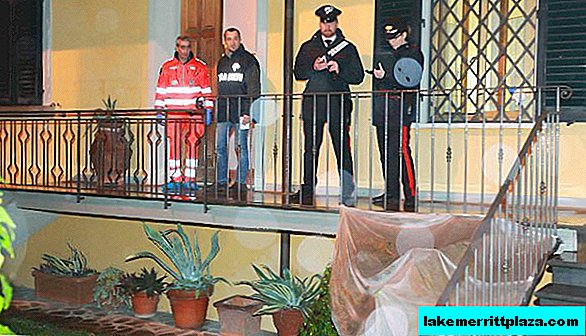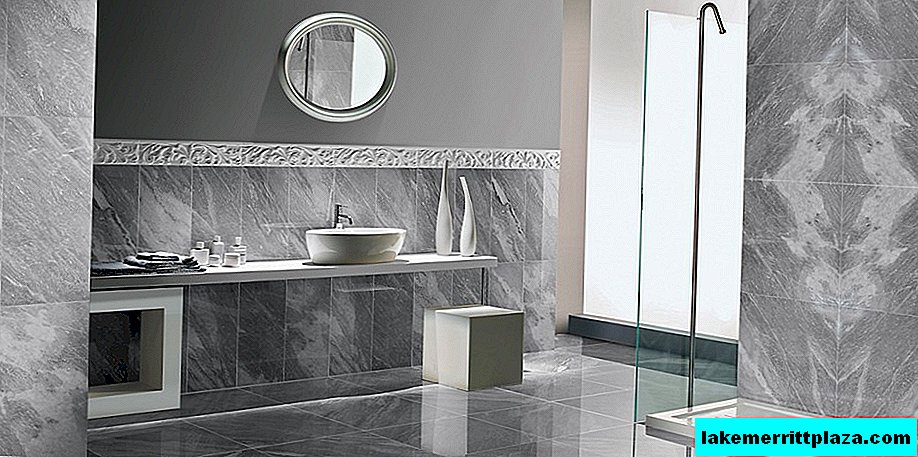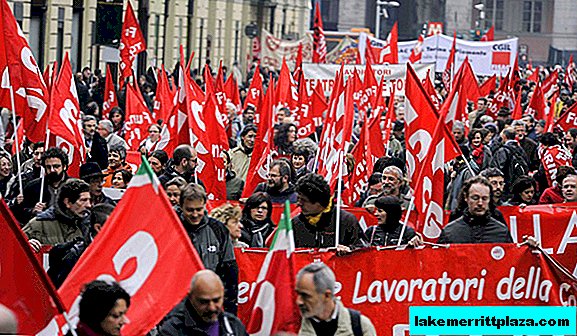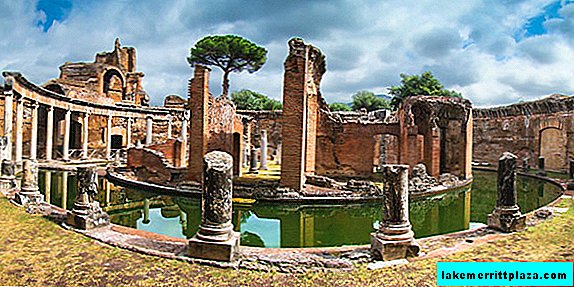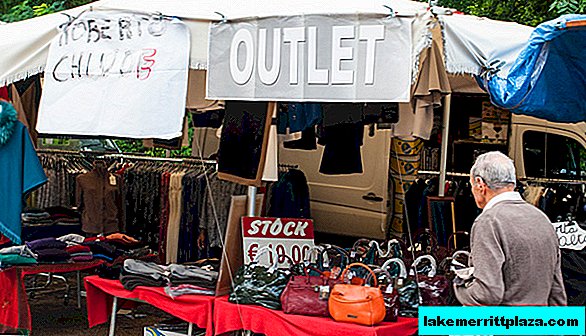The main attraction of Ravenna is its mosaic. She is everywhere - in temples, houses, mausoleums. Its radiance and depth of performance amaze, fascinate, enchant. But Ravenna is famous not only for its unique wall decoration. Here is the house where Byron lived, the grave of Dante, the mausoleums of the ancient rulers, as well as a lot of temples, whose age is one and a half thousand years.
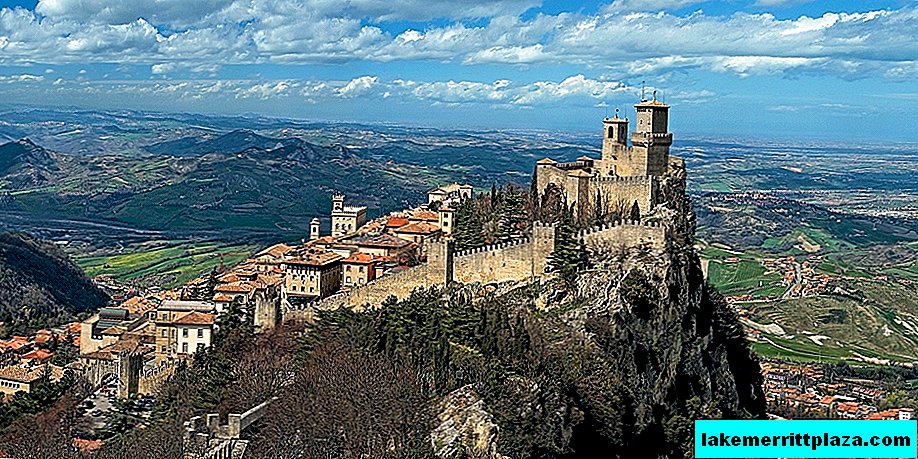
Where is
Ravenna is a city located in the east of Italy. It is the capital of the province of Ravenna, which is located in the Emilia-Romagna region. The province borders the three largest regions of its region: in the west with Bologna, in the north with Ferrara, in the south with Forlì-Cesena. On the east side of Ravenna is the Adriatic Sea (mare Adriatico), which is part of the Mediterranean Sea (mar Mediterraneo).
More than a millennium ago, the city was directly on the coast of mare Adriatico. But over time, the waters receded, and as a result of siltation a lowland formed. Ravenna is now connected to the Adriatic by the Canale Candiano.
The area of Ravenna is 652 km2, and the number of inhabitants exceeds 150 thousand people. The historical center is located on 2 km2. Previously, it was surrounded by fortress walls, of which only a gate remained. And where the lines of fortifications used to stretch, now there is a boulevard ring on three sides, while from the west there is a railway.
Main square
After the XIII century. on the People's Square (Piazza del Popolo) built a house for the ruler of the city, the residence of Bernardino Poleta (la residenza di Bernardino da Polenta), it became the main square of Ravenna. A few years later, the house of the rector of Romagna (palazzo del Rettore di Romagna) appeared here.

When the Republic of Venice captured Ravenna, the Venetian Palace (palazzetto veneziano) was erected on the square, which began to serve as the town hall. In front of him, statues of two saints were erected on granite columns. This is the patron saint of St. Apollinaris (Sant'Apollinare) and Vitaly of Milan (San Vitale), who died for the faith, being buried alive (covered with stones).
When Ravenna re-became part of the theocratic state of the Papal States (Stato Pontificio), the city became its administrative center. In 1544, the rector’s house was expanded to include part of the Venice Palace, and turned into the Apostolic Palace (palazzo Apostolico), the residence of the cardinal and all the Catholic departments of the city.
In 1681, the Polenta house was demolished, and in its place appeared the town hall, known as Palazzo Merlato. It was united by the passage with the Venetian palace. Bishop's residence at the end of the 17th century was renovated and expanded, and from the end of the XIX century. it houses the prefecture.
Today, Piazza del Popolo is a very lively place where various events are constantly taking place: concerts, festivals, fairs, in winter - a Christmas tree. For tourists, People's Square is convenient in that you can quickly get to many attractions of the city. For convenience, signs to the main memos are placed on each corner of the square.
Churches
In Ravenna there are a lot of churches that appeared in the V-VI century. AD Many of them are no longer operational: they are museums. Therefore, you can get inside only after buying a ticket. It’s more profitable to purchase a combined ticket. So, according to one of them you can visit the main attractions of Ravenna: the basilica of St. Vitaly, Baptistery of the Orthodox, New Church of St. Apollinaria, as well as the Archbishop's Museum and the mausoleum of Galla Placidia.
Another unique feature of the ancient temples is the mosaic. Unlike many churches in Europe, the walls and domes of which are decorated with frescoes, here the life of Jesus, the apostles, saints is narrated by paintings lined with colored glass, marble, semiprecious stones, gold, smalt - this is incredibly mesmerizing.
Basilica of St. Vitaly
San Vitale Temple (Basilica di San Vitale) is located near the railway station, on Via San Vitale. This temple is one of the most famous attractions of Ravenna.
Its architecture is a well-preserved monument of the early Christian churches: a temple was built between 527-548. Since at the time of construction the city was under the rule of Byzantium, architects successfully developed western and eastern motifs when developing the facade of the basilica.
But the antiquity of the church is not the main reason for the popularity of the Basilica of St. Vitaly. At the sight of mosaics, arches, domes, capitals, niches, any person entering the temple is enraptured. The multi-colored tiles from which the drawings are laid out shine and sparkle, giving the image a volume effect.

Pictures created by ancient masters tell the story of the life of Christ, the prophets, and the apostles. Of particular value are mosaic portraits of Emperor Justinian (Giustiniano I il Grande) and his wife Theodora (Teodora), made during the life of the ruling couple.
St. Apollinaris Basilica in the Classroom
The Church of St. Apollinaris in Class (Basilica di Sant'Apollinare in Classe) can be found on Via Romea Sud, 224. This street is located on the periphery, five kilometers from the center.
The temple was built one and a half thousand years ago on the shores of the Adriatic Sea, near the port of Klasse, outside the city walls. According to legend, it was here that the first bishop of Ravenna, St. Apollinaria. His relics were found during the construction of the temple, and for a long time stayed inside the temple. But in IX art. due to the constant raids of pirates, the remains of the saint were transferred to the city limits, to the church of St. Apollinaria Nuovo (Basilica di Sant'Apollinare Nuovo). Here they stayed for nine centuries, until 1748. Then the relics were returned to the temple, located in the Class, and placed in the main altar. Also inside the church there are ten sarcophagi, in some of which the bishops of Ravenna are buried.

Interestingly, the construction of the temple took place quickly: it began in 535 and ended three years later. But The mosaic decoration of the church was created for three centuries. Ancient masters gave the mosaic tiles a rounded shape, which created the illusion that the ceiling and walls were covered with a soft beautiful carpet. Since the mosaic was laid unevenly, from different parts of the temple the same place looks different. Unfortunately, the temple was plundered by the Venetians in 1449, and the ancient mosaic can only be seen in the apse. The rest of the decoration appeared after these events.
Cathedral
The Cathedral of the Resurrection of Our Lord Jesus Christ (La cattedrale metropolitana della Risurrezione di Nostro Signore Gesù Cristo) is the main church of Ravenna, located on Via Battistero, 2. It is a temple complex, which also includes the palace of the archbishop (palazzo arcivescovile) , Orthodox baptistery and bell tower built in the tenth century.

The building, which stands on the square now, appeared in the first half of the XVIII century. on the site of the cathedral that was built at the end of the 4th century and rebuilt in the X century. All that remained of it was a crypt and a bell tower of cylindrical shape, which contrasts strongly with the baroque facade. Inside the temple are installed a pulpit of the VI century made of marble, as well as two sarcophagi of those timesmade of marble and decorated with Christian themes. Archbishop Rinaldo da Concorezzo, who died in 1321, was buried in one of them. The second contains the relics of St. Barbatiano, who lived in the first half of the fifth century.
Baptistery of the Orthodox
The Orthodox Baptistery (Battistero degli Ortodossi or Battistero Neoniano) is located on Via Gioacchino Rasponi. This is the oldest temple of Ravenna, decorated with Byzantine mosaics: they built it in the IV-V centuries. You can get here on a single ticket, which allows you to explore the five attractions of Ravenna. Moreover, it is better to start inspecting the ancient buildings from this temple: despite the beauty of its mosaics, the rest of the buildings will be eclipsed by the baptistery.
They built a baptismal church on the foundation of ancient Roman terms (baths), and in the early years it was called the Orthodox Baptistery. This name meant that the temple belonged to the "Christians of the right faith." Here there was a contrast to the followers of the Arian heresy, who also had their own baptistery (built in the VI century, Battistero degli Ariani survived to the present day). This teaching was popular in those years and went against the teaching of the church. In the second half of the fifth century Bishop Neon ordered the temple to be decorated with mosaics, after which the baptistery was named in his honor.
Externally, the baptismal tower is an octagonal brick structure with low apses on four sides of it. In one of them the throne of the 6th century was preserved.

Inside the baptistery is arranged as follows: in the center is an octagonal font. The dome is decorated with mosaic inside. In its center is a medallion depicting a scene of the baptism of Jesus when the Holy Spirit descends on him. Around the medallion in a circle are twelve apostles. The pulpit, behind which the priest reads the Bible, is carved from a single piece of marble. On the walls in a circle are figures of saints who watch the sacrament of baptism taking place in the center.
New Basilica of St. Apollinaris
The new Basilica of St. Apollinaria (Basilica di Sant'Apollinare Nuovo) is located on Via di Roma. They built a court church in 493-526. by order of the ruler of Ravenna Theodorich the Great (Teodorico il Grande) near the royal palace (not preserved).
Like all churches built by this king, the basilica first belonged to the representatives of the Arian current and was dedicated to Christ the Savior. After Ravenna came under the rule of Byzantium, Arianism was forbidden here, and the church, along with other Arian churches, was transferred to the Orthodox. Thus, in 561, it became known as the Church of St. Martino di Tours (Martino di Tours), who lived two centuries before these events and was an ardent opponent of the Arians. As a result of the transformations, all the mosaics of the Arian temple were changed to new paintings or painted over. The rest were saved.

The temple was given its current name after, due to the frequent raids of pirates in 856, the relics of St. Apollinaria from a church located outside the city dedicated to this saint. They were here for nine centuries, after which they returned to their original place.
In the X-XI centuries. near the church a bell tower appeared, the height of which was 38 m. In the XVI century. the floor of the temple was raised by almost one and a half meters due to rising groundwater levels. Because of this, a large part of the mosaic floor was lost, which belonged to the VI century.
Mausoleums
Ravenna is a city where kings lived and ruled for a long time. Therefore, it is not surprising that it was here that many of them built tombs for themselves. The most famous of them is the mausoleums of Galla Placidia and Theodoric the Great. Also, the great poet Dante Alighieri is buried here - his mausoleum is also located in the city.
Mausoleum of Galla Placidia
The Mausoleo of Galla Placidia (Mausoleo di Galla Placidia) is located on Via San Vitale, near the Church of St. Vitaly. It was built for the daughter of the Roman emperor Galla Placidia (Galla Placidia), which from 425 to 437 years. ruled the Western Roman Empire instead of a young son.
In earlier times, historians believed that Galla was buried here. But now scientists refute this opinion, claiming that since she died in Rome, she was buried in a family tomb, located in the capital of Italy.
In any case, there is still no way to determine for sure whether Galla was buried here. The fact is that in the sarcophagus intended for her, there really was a body that was seated on a cypress throne during a burial. There were small windows in the sarcophagus, and in 1577 curious boys put a burning candle in one of them to see what was inside ... After the fire, there were only a few bones, a skull and burnt pieces of wood.

The mausoleum was not only a tomb: for some time it was a chapel chapel at the palace church, and was dedicated to the martyr Lawrence, whose image is placed opposite the entrance. The internal walls and the dome of the mausoleum are decorated with mosaics inside, which is considered the oldest in Ravenna. Unlike other mosaics of the ancient temples of the city, there is no influence of the Byzantine style: when creating paintings, the masters adhered to the ancient Roman-Hellenistic mosaic tradition. Therefore, the mosaic decoration of the mausoleum is very magnificent, and the building is one of the most important monuments of early Christian art.
Mausoleum of Theodoric the Great
The Mausoleum of Theodoric the Great (Mausoleo di Teodorico) is located in the park of the same name Parco di Teodorico, the entrance is from Via delle Industrie or Via Pomposa. In former times, the tomb was located on the outskirts of the city, in the middle of the cemetery. Now it is located 1.5 km from the church of St. Vitaly, on the edge of the park.

This attraction is the most famous building of the Ostrogoths. The mausoleum was built for themselves by their king Theodoric the Great in 520. After his death, he was buried here, but did not stay in the tomb for long. A few years later, Byzantium captured Ravenna, the remains of the king were taken out of the mausoleum, and the structure was converted into a chapel.
Theodoric mausoleum is strikingly different from other buildings of Ravenna: outwardly, it resembles a well-fortified tower-fortress.
For the construction of the tomb, the craftsmen used blocks from Istrian limestone that were mined in Croatia. The dome of the mausoleum was carved out of a piece of solid stone weighing three hundred tons. To set it up, the Goths covered the mausoleum with earth, rolled a dome onto an artificial hill, fixed it, and then dug up the tomb.
The body of the king after the burial was on the second floor, as evidenced by the sarcophagus placed here. Below it was supposed to bury representatives of the royal family, but the Byzantines violated these plans. After the body of Theodorich was taken out of the mausoleum, a modest chapel was built on the first tier: everything looks very ascetic here.
Grave of Dante
The Dante Mausoleum (Tomba di Dante) and the poet's museum are located on Via Dante Alighieri, 9. The tomb was built in 1780, four hundred years after the death of the creator of "Divine Comedy". Before this, Dante could not find peace for centuries and did not stay long in one place.

Dante Alighieri settled in Ravenna after being expelled from Florence (Firenze) in 1303 due to his membership in the White Guelph party. Here he wrote the final part of The Divine Comedy. In the summer of 1321, Dante was sent to Venice (Venezia) as ambassador for peace. Returning to Ravenna, the poet caught malaria and died.
The ruler of the city, Guido Novello da Polenta, wanted to build a magnificent tomb for Dante, but lost power - and could not complete the project. Therefore, the poet was buried at the church of St. Francis In 1519, Michelangelo received permission to transport the remains of Dante to Florence. But upon the arrival of the sarcophagus in the city, it turned out that it was empty: the remains were stolen by the Franciscans, who did not want to give the dust of Dante to the Florentines and hid the urn in the monastery.

In 1780, by order of the papal legate, Luigi Valenti Gonzaga, a mausoleum was erected over the poet’s former grave, placing a marble sarcophagus in it and placing an urn in it. In 1810, Napoleon Bonaparte dissolved the monastery at which the tomb was located, and the monks again hid the remains of Dante, buried under the wall of the chapel of a nearby monastery.
After that, the brothers left the city, and information about the location of the urn was lost. They found it by accident during restoration work in 1865. During the Second World War, the remains of the poet also remained outside the mausoleum, since Ravenna was constantly bombarded. Only at the end of hostilities did the urn with ashes return to the mausoleum, where it remains to this day.
Museums
In Ravenna there is no single ticket that would allow you to see all the attractions of the city that are on the UNESCO list. But there is the opportunity to purchase complex tickets, which allows you to visit several museum complexes. The most popular is a pass for visiting five attractions, where the most beautiful mosaics of Ravenna are located. This is the church of St. Vitaly and Apollinaria, the baptistery, the mausoleum of Galla Placidia and the museum of the archbishop.
For another combined ticket, you can get to the National Museum and choose one of the following objects (or all): the Giorgio Celiberti exhibition, the Church of St. Apollinaria in the Class, the mausoleum of Theodorich. You can also visit several archaeological museums on a single pass.If you do not want to buy a common ticket, you can purchase a pass to enter each exhibition separately.
Museum of the Archbishop
The Archiebiscop Museum (Archiepiscopal Museum), located in the palace, which is located at Piazza Arcivescovado, 1. Here you can see paintings and other art objects that were in the demolished earlier temples. Among them - the creations of Byzantine masters of the VI century.
Particular attention is drawn to the carved throne of the archbishop, made of ivory, as well as a silver cross on which in the VI-VII century. Forty medallions were minted.
At the bottom of the palace is the chapel of St. Andrew the First-Called (Cappella di Sant'Andrea). A chapel appeared at the end of the 5th century. and for a long time served as a house temple to local bishops. The uniqueness of the chapel is that it was the only Orthodox church built under Theodoric, during which Arianism prevailed in Ravenna. Inside the chapel is decorated with various mosaic compositions, the most famous of which is the image of Christ fighting a snake and a lion. These animals for the first Christians personified heresy (in this case - Arianism).
National Museum
The National Museum of Ravenna (Museo Nazionale di Ravenna) is located in the former Benedictine monastery, which is located near the church of St. Vitalia, on Via S. Vitale, 17. Here are collected exhibits from different times, most of which were found in the province of Ravenna.

The exhibition was opened in 1804. The collection is based on church items and artifacts from the monasteries liquidated by Napoleon. Currently, among the exhibits of the museum you can see a collection of Roman coins, weapons, fabrics. Attention is drawn to medieval painting, murals, ivory, bronze. The museum’s courtyard houses Roman sarcophagi and early Christian stone crosses.
Previously, Theodorich’s carapace was found here, discovered not far from its mausoleum. Unfortunately, he was stolen along with the golden decoration of the marble sarcophagus that was found during excavations near the church of St. Francis Where artifacts are now is unknown.
Museum of Art
The Museum of Art of Ravenna (Museo d'Arte della città di Ravenna or MAR) is located in the building of the former monastery of the XVI century. on Via di Roma, 13.
On the ground floor there is an exhibition of modern mosaics, which many tourists recommend visiting. On the second tier - copies of ancient sculptures, which are engaged in students of art institutes. On the third floor there is an art gallery where the works of masters of the XIV - XXI centuries are stored.
One of the museum’s most valuable exhibits is marble sculpture created by Tullio Lombardo in 1525. It depicts a mercenary of the Borgia family on their deathbed.
Virtual courses are provided for museum visitors to visit the already defunct temples of Ravenna. For example, to see firsthand the Chiesa di Santa Maria in Porto Fuori, which was completely destroyed during the Second World War. The museum also has a library, provides creative training courses for various age groups.
Domus dei Tappeti di Pietra
The Domus dei Tappeti di Pietra Museum is hosted on via Barbiani. To get inside, you need to go through the temple of Sant'Eufemia and go down to the basement. There are several rooms of the Roman period, the area of which is 1200 m2. Their floors are adorned with magnificent mosaic floors made of stone and marble.
In total, fourteen mosaics have been preserved, where, in addition to the geometric ornament, paintings with the image of people are laid out. Among them are the Good Shepherd, Dance of the Seasons. To examine the mosaic in detail, the museum has special platforms.

Presumably, there used to be a Byzantine palace, which was built on the foundation of Roman buildings of the III-II century. BC. We found its remains by chance, during the construction of a new house in 1993.
Planetarium
The Planetarium (Il Planetario) is located on the territory of the square Giardini Pubblici, entrance from Viale Santi Baldini, 4 / A. It was discovered in 1985.
The structure has a dome with a diameter of 8 m. A special mechanism ZKP 2 is installed inside the building, which designs an artificial sky. Thanks to this, the visitor can see the sky as it is in the mountains, where there is clean air, there is no extraneous lighting and other interference. In total, here you can see more than 3 thousand stars. Also in the planetarium there is a model of a miniature solar system.
Inside the building there is a hall for lectures, conferences, seminars. A sundial is installed on the south side, and the circle of Hipparchus of Nicaea in the west, which is actually a calendar, which allows you to find out the date of the beginning of spring and autumn.
Interesting houses
Ravenna is known not only for very old churches, mosaics, mausoleums. There are many other interesting structures that can interest a curious tourist. Among them is the house where Lord Byron lived for several years, the most famous work of which is the poem "Pilgrimage of Childe-Harold." Also in Ravenna there is a leaning tower, a fortress, and of course, an opera house, the history of which dates back almost two centuries.
The house where Byron lived
The Palazzo Guiccioli is located on Via Camillo Benso Cavour, 52-54. This house is known for living here by Lord Byron, a British romantic poet. Moreover, the palace did not belong to him: Count Allesandro Guiccioli, husband of Byron's mistress, Teresa, owned it. The poet lived in his house for about two years, Alessandro knew about the lord’s relationship with his wife, and did not protest. Also, this did not prevent them from conducting joint business related to the theater.
But this situation did not suit Teresa. Therefore, she persuaded her father, Count Gamba, to obtain a divorce from Pius VII. The Pope agreed, but with the condition that Teresa would not live with her lover, but with her father. Thus, in 1821, a couple in love moved to the house of Count Gamba. In the same year, Theresa's father and brother were involved in a political conspiracy, and therefore were forced to leave Ravenna. First they went to Pisa, then to Genoa. And all this time the poet followed them until he decided to go to fight for the freedom of Greece. There he was exposed to rain, became very ill, and died at the age of thirty-six.
Currently, the house where the poet lived in Ravenna is under restoration. After the overhaul is completed, there will be two expositions: the Byron Museum and the Risorgimento (the so-called national liberation war in Italy).
Fortress Rocca Brancaleone
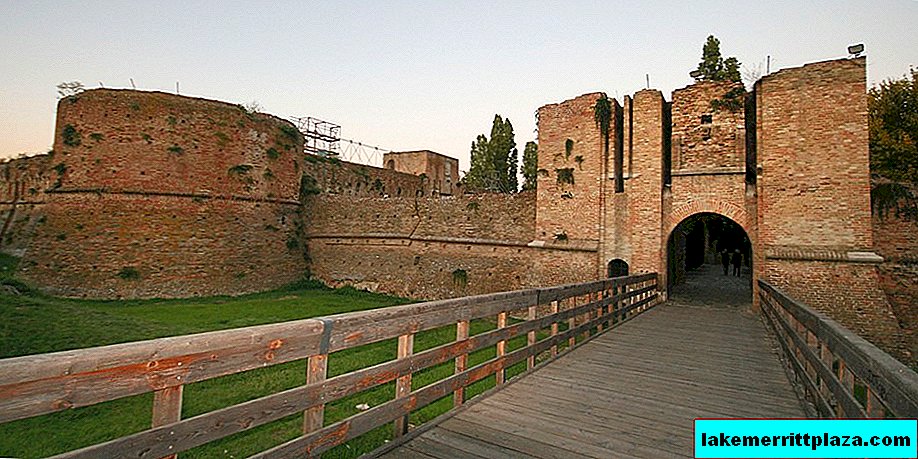
Brancaleone Fortress (Rocca Brancaleone) is located on the street of the same name. The fort was built in 1470, when the city was under the jurisdiction of the Republic of Venice (Repubblica di Venezia). The Venetians erected a citadel not only for protection against external enemies, but also because of fears of a riot in Ravenna: 36 guns looked at the city and only 14 looked out.
The result was a fort surrounded by powerful walls, at the foot of which dug deep ditches. Its total area was 2180 m2. On the south side, a citadel with four towers was placed, the area of which occupied 14 thousand m2. It housed a garrison, stables, warehouses. The fortress survived several sieges, at the beginning of the XVI century it fell twice. At the end of the XIX century. Rocca Brancaleone became the owner of the Rava family. The fortress lost its defense significance, and gardens were built on its territory.
In 1965, the citadel went to the city, which paid 90 million for it.. As a result, after large-scale restoration work, a park appeared here, surrounded by powerful fortress walls. A playground was arranged on its territory, as well as a stage where rock concerts, jazz festivals, and various cultural events are often held. In summer, open-air movie shows are held in the park.
Falling tower
The City Watchtower (Torre Civica) is located on Via Ponte Marino, 2. It is also known as the Leaning Tower: its angle of inclination is so large that the building was reinforced with a steel frame from the outside, and no entrance was allowed upstairs.
Built a tower in the XII century. It was originally called "dei beccai" because of the butcher shops located around it. In the XIII century papal curators ordered the destruction of almost all the towers in the city, but Torre Civica was not touched. For centuries, it served as a watch and signal tower: the guard who was on it, in case of danger, beat the bell.
Since the building was built on unstable soil, which is constantly destroyed by groundwater, the structure began to roll. At the beginning of this century, so that the attraction did not collapse, the top of the tower was removed. Now the height of the structure is 39 m.
Alighieri Theater

The main theater of the city is the Teatro Alighieri Theater, located on Via Angelo Mariani, 2. They built it in 1852 instead of the very dilapidated Teatro Comunitativo.
The auditorium of the Alighieri Theater was designed for 830 seats, and the architects gave its neoclassical style to its facade. The first few decades were constantly staged by Giuseppe Fortunino Francesco Verdi, Vincenzo Bellini, Domenico Donetzetti (Domenico Gaetano Maria Donizetti).

In 1959, the theater was closed for overhaul, which lasted eight years. As a result, the scenes, the hall were completely redone, a new lighting system was installed, new chandeliers, upholstery on the chairs appeared. After the opening in the theater, they began to stage more opera productions, dramatic plays, and give concerts of symphonic music.
Camping
Guests of Ravenna can not only see man-made sights, but also relax in nature both in the city and outside it. For example, not far from Ravenna there is a national park, within which many representatives of the animal world live, as well as a Safari park, where more than seven hundred animals live. Divers will also find something to do here: the Paguro platform located on the seabed has long been one of the most visited places on the Adriatic Sea.
Hanging gardens
Hanging gardens (I Giardini Pensili) are located on Piazza S. Francesco, on the roof of the Palazzo Della Provincia. Here you can relax on a hot summer day.

Palazzo Della Provincia was built on the ruins of the burnt palace of Rasponi (Palazzo Rasponi), from which only a small crypt (La cripta Rasponi) is located, located under the Hanging Gardens. Inside the crypt you can admire the ancient mosaic floors and works of modern mosaic art. There is also a small altar for services. It is worth noting that crypto has never been used for its intended purpose.
From the crypt you can climb into the garden, which is surrounded by powerful walls around the perimeter, which drown out the street noise. There are a fountain, picturesque thickets, flower beds, benches. There is also a small brick tower, built in the Neo-Gothic style, the entrance to which is closed. From here you can go to the site, because of which the place was called the Hanging Gardens. The large arch of the garden is made of a marble watch dial that was once housed in the churches of San Sebastiano and San Marco. The site offers a beautiful view of the surroundings.
Regional Park Delta Emilia-Romagna Po
6 km from Ravenna, near the church of St. Apollinaria in the Class is Parco Regionale del Delta del Po, whose area is almost 54 thousand hectares. There are a lot of forests, lakes, rivers, in addition, the park borders on the sea. Ravenna includes an area of 7.3 thousand ha, the most important area is Punta Alberetewhere loafs, cormorants, yellow herons nest. There are also fallow deer, deer, foxes, porcupines, flamingos, nutria, turtles.
For vacationers, several tourist routes have been developed here, including boat trips along the river bed and horse riding. Hiking and bicycle paths are available for walks. You can find out more about the park at parcodeltapo.it
Safari Park
Safari Ravenna is located 16 km south of Ravenna, in the western part of the Delta Emilia-Romagna Po Regional Park. Exact address: Via dei Tre Lati, 2x, 48125 Savio, Ravenna.

This place is a zoo where more than a hundred species of animals live on 35 hectares of land: lemurs, kangaroos, hippos, zebras, camels, ostriches. There are also antelopes, zebras, elephants, giraffes. The enclosures here are very spacious, and animals can move freely within them. Only the most bloodthirsty predators live in the cells - lions and tigers, as well as hooligan monkeys.
You can move around the park by your car. There is also a small train of three wagons. On their windows there are grilles made so that neither animals nor humans suffer from communication with each other. Inside the wagons there is food that can feed the animals living here. The train route is designed so that visitors can enter directly into the territory of the aviary. More details about the zoo here: www.safariravenna.it.
Paguro Platform
Not far from Ravenna, in the depths of the Adriatic Sea, there is a very interesting place for divers. This is the Paguro Platform, which is located on the seabed opposite Porto Corsini. This is the name of a small city located on the site where the Kandiano channel flows into the sea.
A platform appeared in the middle of the last century after gas reserves were discovered in the bowels of the Adriatic Sea. In the fall of 1965, disaster struck the coast of Ravenna: a gas eruption occurred during the work. As a result, a fire broke out on the platform, after which it exploded and drowned, plunging to a depth of 25 m. Three engineers died, a column of water rose 30 m above sea level, and a huge crater appeared at the bottom. The eruption was stopped only three months later.
The platform has not been removed from the bottom of the sea - and since then it has been a popular place among diving enthusiasts, since in addition to the sunken structure, you can well see the inhabitants of the sea who have found refuge here. Most often here you can see starfish, lobsters, shrimps, crabs, eels, sea ruffs.
How to get there
Despite the fact that Ravenna is located near the sea and is connected by a canal, you can get here by sea only on a cruise ship or on a yacht. Ferry crossings are currently not serviced. There is also no airport near the city, so people who fly to Italy by plane will have to travel with transfers. At a distance of 90 km from the city there are three airports, from which you can get to Ravenna by bus, train, but most conveniently by car. Transfer can be ordered at kiwitaxi.ru.
If a decision is made to travel to Ravenna by train, the train schedule can be viewed here: www.trenitalia.com. Also, buses from different cities of Italy and Europe come here.
By plane
Closest to Ravenna, at a distance of 40 km, is the airport in Forlì (Aeroporto di Forlì). A little further - in Bologna (Bologna) and Rimini (Rimini). There is also an airport in Venice (Venezia), but the road from it to Ravenna by land will take from two to three and a half hours.
From Aeroporto di Forlì, Ravenna can be reached by car or bus. The bus station is a three-minute walk from the airport, on Via Carlo Seganti. The road to Ravenna takes about an hour. The bus schedule can be found here: www.startromagna.it.

The international airport named after Federico Fellini (Aeroporto internazionale Federico Fellini), which is located in Rimini, is 70 km from Ravenna. Aerostazione is a short walk from the airport. From here, take the bus to the 4 Rimini Fs bus station on Via Dante Alighieri. Then you need to walk to the Rimini train station or bus station, which are located on the same square, at Piazzale Cesare Battisti. Hence, an hour drive to Ravenna by train or bus. You can also order a transfer from the airport on the website kiwitaxi.ru

Six kilometers from Bologna is the Aeroporto Internazionale Guglielmo Marconi. It is 87 km from Ravenna. This is an hour away by car. The journey by bus and train will take two hours: first you need to get from the airport to the Piazza XX Settembre. Here are the railway station and the bus station Bologna central bus station, from which there are transport several times a day to Ravenna, spending 1 hour 20 minutes on the way. The bus schedule is available here: www.orari-pullman.it.
By train

Ravenna Train Station (Stazione Di Ravenna) is located at 13 Piazza Luigi Carlo Farini, a ten-minute walk from the center. Trains come here that run between the cities of Rimini - Ferrara (Rimini - Ferrara), Ravenna - Faenza (Ravenna - Faenza), Ravenna - Castel Bolognese (Ravenna - Castel Bolognese). There are also trains to Bologna, Venice (Venezia), Verona (Verona).
If a traveler travels from Rome (Roma), it must be borne in mind that a direct train travels only once a day. Therefore, many get with a change in Bologna. From Milan (Milano) there is no direct communication with Ravenna.
By bus

There are three bus stations in Ravenna where commuter, intercity and international buses come. Therefore, it is first necessary to clarify exactly where the bus stops, especially since stops are also possible in other places. The bus terminal may be at:
- Piazzale Aldo Moro - from the back of the railway station;
- Piazza and Viale Farini - are located right next to each other, opposite the railway station;
- Via Trieste.
The bus schedule can be found here: www.flixbus.ru/raspisanie-ostanovki/ravenna

By the sea
The Port of Ravenna (Porto di Ravenna) is located on Via Antico Squero, 31. It is one of the most important ports in Italy in terms of freight traffic. But ferry crossings are currently not served. More details about the port of Ravenna and its work can be found here: www.port.ravenna.it.

But not far from Ravenna, on the Adriatic coast, where the waters of the Canciano channel flow into it, there are two cities Porto Corsini and Marina di Ravenna. They are separated from each other by a channel, which can be crossed through by ferry. Porto Corsini has a Cruise Port, where cruise ships stop, including those that go to Greece, Cyprus, and Turkey. Marina di Ravenna has the option of mooring yachts. Half an hour from here to Ravenna by bus, but it is better to book a transfer.

